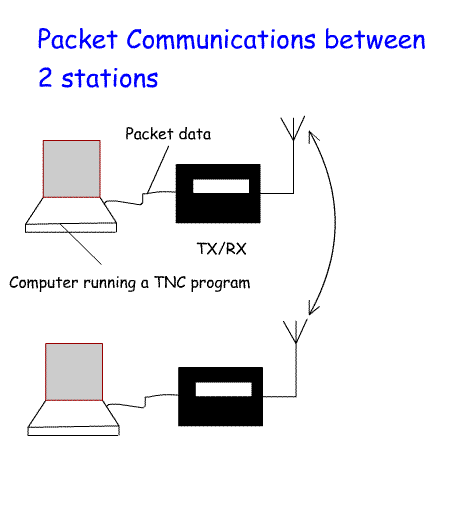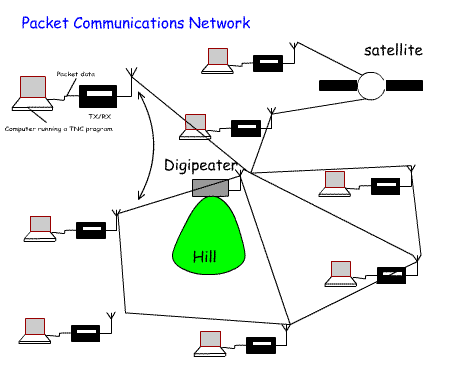
| ADVANCED LESSON 63 |  |
| LEARNING OBJECTIVES and NOTES | |
| Operating Practices and Procedures - Packet Radio | |
|
8a.1 Recall that Packet radio transmits messages in data format that
can be received directly, stored in a mailbox for reception at a later
date or forwarded through a network of mailboxes. Understand the difference between store and forward mailboxes and digipeating. Packet Radio involves sending bursts of computer generated data to another receiver. The packet signal will include information such as callsign of sending station, callsign of receiving station, location of transmitting station, route, error correction details, together with a message. In the early days of packet (1980's) when personal computers were less common a typical packet station would consist of a terminal (screen and keyboard) connected to a TNC (Terminal Node Controller) which was in turn connected to a radio microphone input. The country had a chain of packet repeaters. In addition a TNC in your shack could act as a repeater. The simplest form of packet communication was to simply send a message directly form you TNC to a local amateur's TNC. You would address it to their callsign or to all TNCs (a CQ call). A more complex system would be to route the packet signal through a local amateur's TNC to another amateur. You could use multiple amateur packet stations to route your signal to its final address. Packet repeaters (digipeaters) were often located in high positions. You could send a packet to your local digipeater for forwarding to the next digipeater until it reached its destination. TNCs included a mailbox. When a packet message reached your modem it was stored in the mailbox. You could open the mailbox and read the messages at the end of the day or whenever. Digipeaters also had mailboxes that could save mail until you accessed them. As home computers and the Internet grew in popularity packet was used less frequently and many of the digipeaters closed. There has been a resurgence of packet in the form of APRS in recent years. Transmitters are linked to GPS receivers. A packet is generated incorporating the position of the transmitter, callsign etc. These can be received directly and the position and any messages plotted on a computer map. Positions are also placed on an internet site and so it is possible to look at the position of any stations in the world. APRS uses the same coding system as used for packet. Nowadays TNCs are replaced by software on the computer which do the same thing. Some of the amateur satellites, including the Space Station have mailboxes on board. So, a packet signal can be uploaded from the UK when the satellite is overhead and downloaded 45mins later when the satellite is over Australia. Most Packet communication occurs on 2m with many stations sharing the same frequency. |
  |